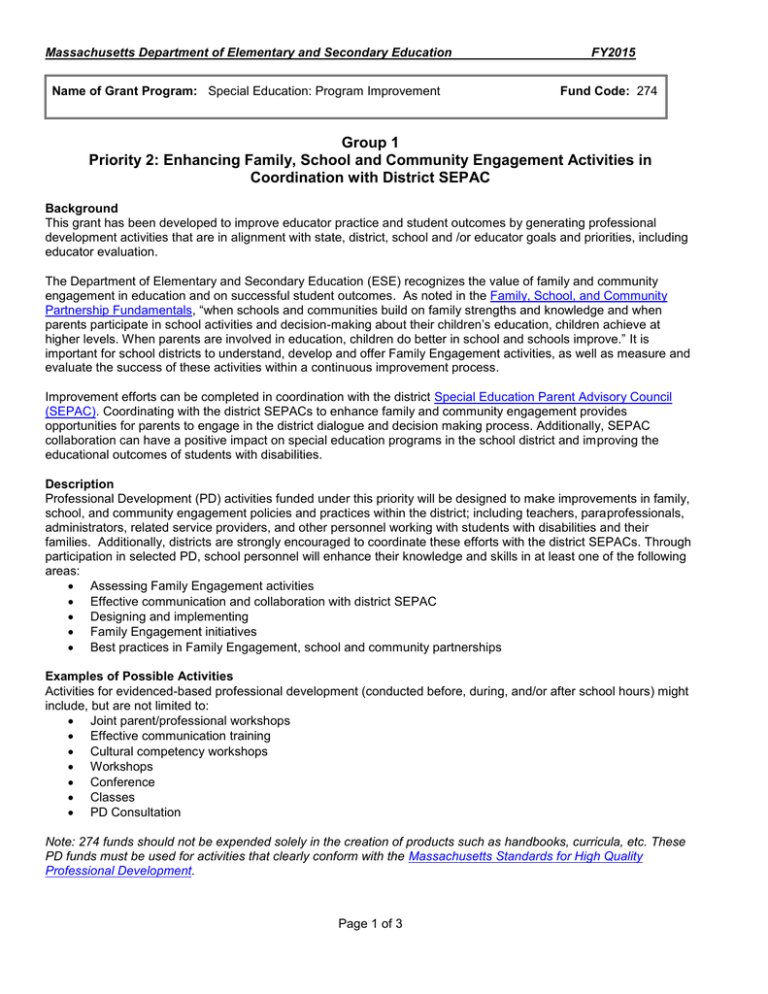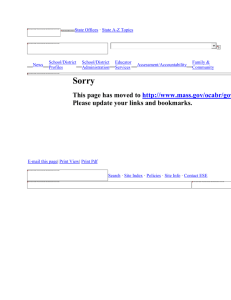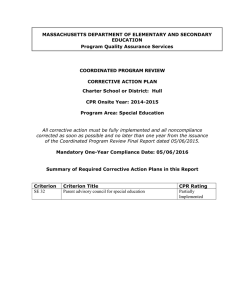PartIIIa Group1Priority2
advertisement

Massachusetts Department of Elementary and Secondary Education Name of Grant Program: Special Education: Program Improvement FY2015 Fund Code: 274 Group 1 Priority 2: Enhancing Family, School and Community Engagement Activities in Coordination with District SEPAC Background This grant has been developed to improve educator practice and student outcomes by generating professional development activities that are in alignment with state, district, school and /or educator goals and priorities, including educator evaluation. The Department of Elementary and Secondary Education (ESE) recognizes the value of family and community engagement in education and on successful student outcomes. As noted in the Family, School, and Community Partnership Fundamentals, “when schools and communities build on family strengths and knowledge and when parents participate in school activities and decision-making about their children’s education, children achieve at higher levels. When parents are involved in education, children do better in school and schools improve.” It is important for school districts to understand, develop and offer Family Engagement activities, as well as measure and evaluate the success of these activities within a continuous improvement process. Improvement efforts can be completed in coordination with the district Special Education Parent Advisory Council (SEPAC). Coordinating with the district SEPACs to enhance family and community engagement provides opportunities for parents to engage in the district dialogue and decision making process. Additionally, SEPAC collaboration can have a positive impact on special education programs in the school district and improving the educational outcomes of students with disabilities. Description Professional Development (PD) activities funded under this priority will be designed to make improvements in family, school, and community engagement policies and practices within the district; including teachers, paraprofessionals, administrators, related service providers, and other personnel working with students with disabilities and their families. Additionally, districts are strongly encouraged to coordinate these efforts with the district SEPACs. Through participation in selected PD, school personnel will enhance their knowledge and skills in at least one of the following areas: Assessing Family Engagement activities Effective communication and collaboration with district SEPAC Designing and implementing Family Engagement initiatives Best practices in Family Engagement, school and community partnerships Examples of Possible Activities Activities for evidenced-based professional development (conducted before, during, and/or after school hours) might include, but are not limited to: Joint parent/professional workshops Effective communication training Cultural competency workshops Workshops Conference Classes PD Consultation Note: 274 funds should not be expended solely in the creation of products such as handbooks, curricula, etc. These PD funds must be used for activities that clearly conform with the Massachusetts Standards for High Quality Professional Development. Page 1 of 3 Demonstration of Proficiency A requirement of high quality PD is that educators apply their learning and demonstrate subsequent proficiency in the relevant subject area. The proposed PD activity(ies) must include a description of how the district will assess and measure the changes in educator knowledge, skills, and/or practices resulting from the proposed professional development to ensure that it is meeting the targeted goals relevant to the desired student outcomes. Educators may demonstrate proficiency in this priority area through means such as: Conducting joint parent/professional planning sessions Increasing attendance at current parent activities and collecting feedback from participants Increasing the number of opportunities for parents to engage Assessing Family Engagement initiatives Developing district-wide Family Engagement strategies that are directly connected to student learning Assessing and establishing Family Engagement policy and practices Implementing Best Practices for Family, School and Community Partnerships Assessing readiness to enhance Family, School and Community Engagement practices Increasing SEPAC collaboration in district initiatives SEPAC development In order to better disseminate promising practices statewide, ESE may request that districts share products and outcomes resulting from this PD. Networking ESE may offer districts the opportunity to attend one or more statewide networking meetings in 2014-2015 around this priority. These meetings may include opportunities for collaboration, the sharing of best practices, and focused training in the above priority area. More information about these meetings will be announced in the fall of 2014. OVERVIEW OF FUND CODE 274 NARRATIVE REQUIREMENTS Professional Development Assurances Statement A. Overview: Please select one of the following FY2015 priorities. All professional development (PD) in this application must align with the selected priority below. 1. Which priority will the proposed PD address? 2. Choose the topic(s) that best aligns with the proposed professional development. B. Propose activities to be funded through the 274 grant: 1. Identify and briefly describe the proposed PD activity(ies). 2. Identify the goals and objectives for the proposed PD. Note: Goals/objectives must target improvement in educator practice and demonstrate a relationship to student outcomes. a. SMART Goal – Learning outcomes for students with disabilities (Smart Goal Definition: Specific and strategic; measurable; action-oriented; rigorous, realistic, results-focused; timed/tracked) b. SMART Goal – Learning outcomes for Educators (Smart Goal Definition: Specific and strategic; measurable; action-oriented; rigorous, realistic, results-focused; timed/tracked) c. Does the proposed PD support any state, district, school, and/or educator goals or priorities? Please Explain. 3. For each activity, provide a proposed timeline, including the number of contact hours and the name(s) of provider(s). Note: If you are proposing individualized, rather than school or district-wide PD and have yet to identify a provider(s), please describe the type of provider you will be seeking and how you will ensure that the selected professional development will be aligned with the above priority and contribute to district professional development goals. Page 2 of 3 4. Describe the job embedded activities or plans for participants to apply their learning to the particular content and/or context. 5. Identify the professional role(s) of targeted participants District Level Administrators Special Education Teachers Principals Parents Teachers Paraprofessionals Related Service Providers Other____________________ C. Data-based Rationale for PD Activities: 1. What data did you analyze that led you to this proposed PD? IDEA Part B State Performance Indicator Data IDEA Part B Determination Level Data Performance Data MCAS Results Teacher Surveys Conditions for School Effectiveness Data School Safety Discipline Report Other____________________ 2. Based on the data you analyzed, what is the rationale for the proposed PD? D. Outcomes and Evaluation: How will you assess and measure the changes in educator knowledge, skills, and/or practices resulting from the proposed PD to ensure that it is meeting the targeted goals relevant to the desired student outcomes? Page 3 of 3





